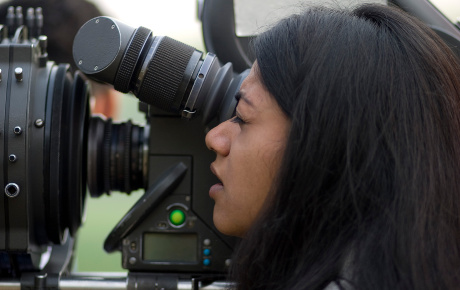
Rubaiyat Hossain.
Bild: Pressbild
Talk with Made in Bangladesh director Rubaiyat Hossein
2020-03-27 | Supriti Dahr

INTERNATIONAL
– Basically, bringing out the lives of different classes of women is what I’m interested in. While the nature of the struggle may vary depending on the class she belongs to, ultimately, the core of the battle always remains the same, film director Rubaiyat Hossain tells Supriti Dhar in a talk about her latest works.
ABOUT/Rubaiyat Hossain
Rubaiyat Hossain is the director of films Made in Bangladesh, Under Construction and Meherjaan. She is one of today’s most prominent women filmmakers from the South Asian country, Bangladesh.
Supriti Dhar is a journalist and activist from Bangladesh. This article is published in cooperation between Feminist perspective, PEN/Opp and Norrköpings kommun.
Rubaiyat Hossain’s latest film Made in Bangladesh is based on the garments workers of Bangladesh and the main protagonist has been portrayed by an actual garments worker who has no previous experience of acting or education. It was not necessary to turn an educated and experienced actress into the character of a garment worker belonging to an economically disadvantaged class with the help of makeup. The director was able to use the natural mannerisms of the actress to portray her character quite successfully on the celluloid, and this is where her talent becomes quite apparent.
Hossain’s first film Meherjaan was based on the 1971 Liberation War of Bangladesh and caused her to face a lot of controversies. Anyone who knows even a little about the history about Bangladesh would be aware that 1971 and the liberation war is a very sensitive issue in the life of the nation. The issue of liberation war falls almost at the same level as religious zeal.
While making a film on such a sensitive issue, the Director portrayed a softer side of the Pakistani Army that angered the Bangladeshi audience. The audience simply refused to give in even an inch in the way of empathizing with an Army that is responsible for slaughtering three million Bangladeshi lives and raping two hundred thousand Bangladeshi women within a period of just nine months. As a result of their protests, the director had to see her very first film being removed from theatres.
However, that didn’t intimidate Hossain. Because then she made <enm>Under Construction. The woman-centric film became quite popular. And she finally gained acceptance from the Bangladeshi audience.
After premiering at the 2015 Seattle Film Festival, Under Construction was released in the Bangladeshi theatres on 21st January of 2016. The film was also released in 20 theatres in France where it ran for weeks. The film portrays the self-discovery of a middle-class woman named Roya with the contemporary Dhaka city as a background. A comparison between the life of garment worker Moyna and that of Roya has been used to portray a unique perspective on women’s struggle in city life in the film.
In 2016, Hossain received the 41st Bangladeshi National Film Festival Award as well. She also received several international awards for this film.
While speaking with Hossain on behalf of the Swedish Feminist Magazine Feminist Perspective, the Interviewer came to know that Hossain got the idea of her third project while still working on Under Construction. Working closely with the life of a garment worker sparked the idea for her next film and from that perspective, it can be considered a continuation of Under Construction.
Ever since premiering in Toronto last year, Made in Bangladesh has been shown in numerous theatres in the United Kingdom, France and has been shown in a number of film festivals in Portugal, Japan, and Sweden. If everything goes as planned, it will be released in the United States on June 5th. The rest of the conversation continued around this film.
Why is the woman central to the story in your film? Is it because you are a woman yourself?
– Women have always been at the center of my ideas. Basically, bringing out the lives of different classes of women is what I’m interested in. While the nature of the struggle may vary depending on the class she belongs to, ultimately, the core of the battle always remains the same. Although this struggle depends on her socio-economic and anthropological status. The attraction of being able to work with life-like characters is also an aspect of my film-making.
Which class does the protagonist of Made in Bangladesh represent?
– The protagonist is based on an actual garment worker; her name is Daliya. In the film, her name is Shimu. She has portrayed her own life in the film. Daliya has been working in the garment industry for many years, has become empowered, took care of her entire family, including her parents and her siblings. She has led the local Trade Union as its President. She has always had a strong voice when it came to speaking up for her own rights. At home, she has had to compromise with her husband at home and with her boss at work. At one point, she became a mother. She left her child with her mother to work in Jordan for more money. She returned from Jordan after a year and was without a job for a period during which she worked in the film. After a while, it became simply impossible for her to stay with her husband any longer, so she had to divorce him.
These garment workers, the women who are coming from remote villages and starting a life in the city. How do you view these women?
– I see this change very positively. The way these women walk in public places, I can’t do that myself, even though I come from a much more privileged social class. They are quite outspoken, spirited and energetic. Very few of them are rigid. They are very forward in taking decisions as well. A lot of them are single mothers, but they are working very wisely, taking charge of things. I believe that a revolution has taken place in this particular social class. They are no longer just the victims. They can now stand up to protect themselves. If they don’t have a good understanding of their partners, they can even think of divorcing now. They have that strength.
– You can say that these 18 to 25-year-old women have been able to come out of these so-called stereotypes. They seldom wear saree, They wear salwar kameez for its convenience, they go to Beauty Salons, they go to movies, they dance. As they have gained a sort of independence, they no longer have to depend on someone else. Instead, many others are now dependent on these women.
– I have noticed another interesting thing that every morning when they go to work, they refer to going to the garments factory as going to the ”office”. This job works as a form of mental freedom for them. This has inspired me.

Daliya Akter is the garnment worker who’s life Made in Bangladesh is based on.
Tell us a little more about Shimu, the protagonist of Made in Bangladesh.
– A few days after we met Daliya told me, ”You’re doomed if you marry, doomed if you don’t”. It stuck with me and that’s why I used this dialogue in my film. As an individual, Daliya is very enthusiastic. It has impressed me a lot! As we talked, I could sense that there is an innate feministic attitude in her that is deeply ingrained. She has played all the roles at once. That of a daughter, a wife, a mother, and a factory worker. In spite of being a village girl, she has the courage to face up to such a huge structure. She is very self-confident. From a very ordinary girl, Daliya and Shimu become an extraordinarily courageous individual, and this is where her strength lies. In a way, the women from the class that Daliya belongs to have more power to make such decisions than the women from more privileged classes of the society.
In today’s Bangladesh, there are many different trends of ongoing women’s movements. How would you evaluate them?
– See, in Bangladeshi context, you will find that from the Prime Minister herself to the parliamentarians, many organizations, and even business administration heads are women. That means that the presence of women in the public sphere has increased. However, there has been little change in her life in the private sphere. The little change that we see has been possible due to the activities of the NGOs. While working in the 90s, I have seen how the NGOs have been working for the empowerment of women. However, now those NGOs’ activities are no longer the same as before. Another thing is, there has never been a feminist movement in our country. Work is being done disjointedly. And I would say that the work of NGOs is a lot like putting band-aids. They are temporarily covering the scars. But no one is there to form a strong movement, there is no solidarity, whether you are speaking about the women’s organizations or women’s leadership.
The percentage of violence against women has increased a lot compared to before. Do you think it has anything to do with the empowerment of women?
– It is our misfortune that as women are being empowered, the violence and abuse of women is also increasing, we are seeing changes in the level of abuse. And we never hear any of these incidents of abuse being brought to justice. On top of that, we have a very repressed society. However, there are a few positive changes in the middle of all these. For example, rape used to happen before as well, but now its actually viewed as a crime. While on one hand women’s glamour and beauty are being exploited to showcase them as sexual objects, on the other hand, their stories are also being told. This is a positive change.
You are saying there is a lack of solidarity when it comes to the women’s movement. Why do you think this is happening?
– It is true that of late women have moved forward, this is really happening. Conversations around feminism are getting louder, however, in most cases, this is shown in a negative light. This backlash has started since Taslima Nasreen. Besides, Gender Studies has never become a part of the mainstream education system in Bangladesh the way it has happened in other countries around the world. It has to start from Academia, the consciousness should start to grow from the ground level. Otherwise, the disconnection and lack of a united platform will remain prominent.
What is your next project?
– I would like to work with women migrant workers. I saw Daliya, the main character of Made in Bangladesh, how she managed to go to Jordan as a migrant worker leaving her one-year-old son behind and I was surprised seeing her boldness. Then I decided to make my next film on their lives. I am already speaking with such women. In spite of so much abuse, torture, fear of death and rape, these uneducated village women are leaving their husbands and children behind to go work in the Middle Eastern countries simply for the sake of survival. These women don’t have any future nor any present.
Kommentarer
Du måste vara inloggad för att kunna lämna en kommentar.
























MEST KOMMENTERAT
SENASTE KOMMENTARERNA
Om Var Grupp 8 en feministisk organisation?
Om #bildskolan 21: Att äta Den Andre
Om #bildskolan 21: Att äta Den Andre
Om Porr handlar om betalda övergrepp
Om Nobels fredspris till kampanj för att avskaffa kärnvapen
Om Feministiskt perspektiv öppnar arkivet och startar på nytt!
Om Rödgrönt ointresse för fred och nedrustning borde oroa många
Om Var inte målet att vi skulle jobba mindre?
Om Feministiskt perspektiv öppnar arkivet och startar på nytt!
Om Feministiskt perspektiv öppnar arkivet och startar på nytt!
MEST LÄST